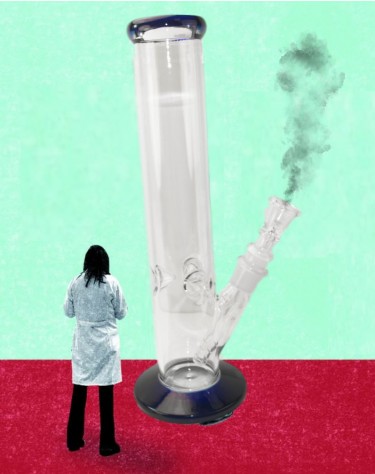
Does your phone know if you’re high?
Some researchers believe that they managed to use your smartphone to tell whether or not you are affected by cannabis. According to the preliminary study, however, they were able to detect impairments in 90% of the cases by using “time functions” and “telephone sensors” at the same time.
Here is the methodology used by the researchers with a direct link to the study;
Young adults (ages 18-25) in Pittsburgh, PA who reported cannabis use at least twice a week conducted up to 30 days of daily data collection: telephone surveys (3 times / day), self-initiated reports of cannabis use (start / Stop time, subjective assessment of cannabis poisoning: 0–10, 10 = very high) and continuous telephone sensor data. We have tested several models with the Light Gradient Boosting Machine (LGBM) to be “not intoxicated” (rating = 0) vs. 10). We only tested the importance of time characteristics (i.e. day of the week, time of day) compared to smartphone sensor data for model performance, since time characteristics alone could predict “routines” in cannabis intoxication. – SOURCE
In other words, the test was conducted by combining cell phone data such as accelerometer and GPS and then comparing it to the self-reported data from the surveys that the participants completed. This enabled their algorithmic approach to narrow down “periods of noise” more precisely.
However, how this would work in the real world is difficult to say. It’s not that consumers sit down and take surveys after every smoke. The test data could, however, provide some insight into the average consumption time / data in order to be able to identify “higher frequencies of impairments”.
Of course, this technology is currently the Holy Grail for both cannabis activists and law enforcement agencies, as once cannabis is legalized at the federal level, mere detection of THC will no longer be the protocol for poisoning. Apps like DRUID are already working on it.
This is because THC can stay in your system for up to 90 days.
Problems with studying
While the researchers claim they were able to identify impairments 90% of the time, the study was conducted in a controlled environment. As mentioned earlier, people don’t report their cannabis use themselves to an app that quantifies whether they are high or not.
Even more so when you hear some quotes from researchers like this one;
“With the help of the sensors in a person’s phone, we may be able to identify when a person may be suffering from cannabis poisoning and conduct brief intervention when and where it will have the greatest impact to reduce cannabis-related harm,” said Tammy Chung, professor of Psychiatry, Rutgers Institute for Health.
As you can see, the authors use this more as a harm reduction tool – meaning it could work for people thinking about stopping their cannabis use but wouldn’t work to tell if someone is impaired while driving.
It seems that this tool is more about mapping “habitual user patterns” that allow them to intervene whenever there is a trigger to use cannabis. In this scenario, participants are much more likely to report when they smoke cannabis, especially if that is part of the protocol.
For example, if someone believes they have a “problem” with cannabis use, this tool can be used to track their behavioral patterns, allowing harm reduction specialists to plan when someone is most prone to relapse.
As a tool to help someone overcome compulsive behavior – this could indeed work.
In the real world, however, there appear to be no practical uses for assessing impairment. Nonetheless, the main purpose of the study was to show that this “could be done,” as the following quote sums it up;
“This feasibility study demonstrates the feasibility of using telephone sensors to detect subjective cannabis poisoning in the natural environment with possible effects on triggering just-in-time interventions,” concluded the study’s authors.
Using smartphones for addiction
While this study focused on the detection of cannabis impairment, the application of this technology could serve the broader goal of harm reduction. Addiction is a compulsive act, that is, several neural networks that are closely intertwined with one another fire at the same time.
You will usually find that when someone is addicted to a particular substance, there will also be “codependencies” which will also manifest. For example, someone who is an avid smoker may also be an avid video game gamer. Whenever you engage in one of the activities – trigger the other and together form a feedback loop.
This mandatory behavior can be quantified using your smartphone and, as the researchers of this study found, can be up to 90% accurate if you have willing participants.
In fact, the ability to depict coercion in a real-world scenario could dramatically improve harm reduction effectiveness by allowing one to plan accordingly.
Imagine a world where someone comes up to you and says, “I would really like to give up X-addiction”. Unless critical measures are required, such as B. If a patient continues to use it will result in immediate death, then immediate immediate action will be taken to help the patient give up his habits.
However, if the addiction is not life threatening, telling the patient to just go on living as normal for 30 days and just write down when they used it and what conditions triggered the craving – over a period of a month, you can get a decent card of the Have addiction.
It only makes sense that with this data you could more effectively plan a recovery path that avoids critical triggers while taking preventative measures to minimize relapse.
Personally, I don’t like the rehab industry, in many cases it’s just money mills. However, I think if we could use technology – currently being used against us by creating psychometric digital avatars based on our behavior – and use it for our personal development; We could make some significant changes very quickly.
This is not the first time this has been tried either, and one day we will have a device that can recognize how impaired someone is by simply scanning their vital signs and testing their reaction time.
What do you make of it? I would love to read about it in the comments!
SMART PHONE APPS TO BE HIGH, READ MORE ..

CAN THE DRUID APP GET IT FROM A DUI FEE, WE ASKED!
OR..

HOW A CHEMISTRY SOLVES THE MARIJUANA BREATHALYZER PROBLEM.

Post a comment: